12 Key Challenges of Customer Care and Their Impact
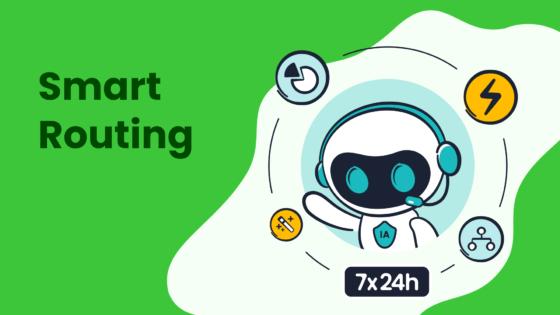
Modern challenges of customer care have become increasingly complex. Businesses today face twelve key challenges of customer care: rising customer expectations, inconsistent service quality, slow response times, difficulties with omnichannel support, lack of personalization, technology integration hurdles, insufficient training, managing difficult customers, high agent turnover, data privacy and security concerns, handling customer feedback, and scaling customer service operations effectively. Recent data shows that 93% of customer service teams acknowledge that customer expectations are higher than ever, while 80% of consumers regularly experience negative customer interactions. Companies like Sobot leverage Sobot AI to tackle these challenges by delivering AI-powered solutions that enhance customer support and significantly boost customer satisfaction.
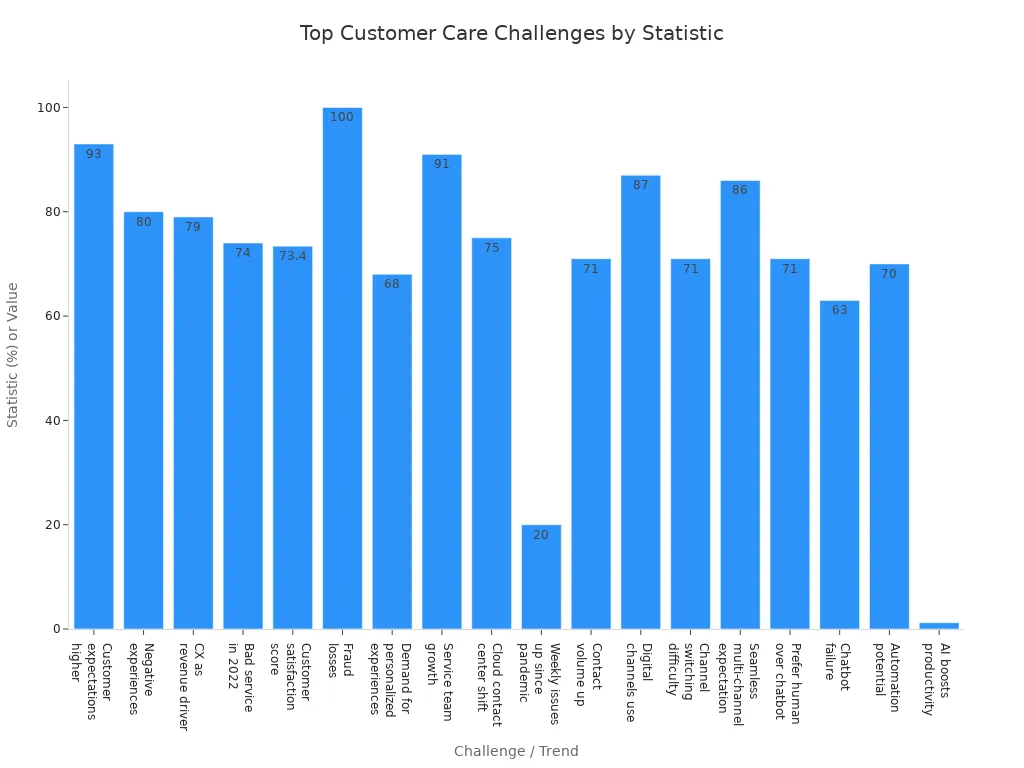
| Challenge / Statistic Description | Statistic / Finding |
|---|---|
| Customer expectations are higher than ever | 93% of customer service teams agree |
| Negative customer experiences | 80% of people regularly encounter them |
| Increase in contact volume | 71% of support leaders report increased volume |
| Difficulty managing multiple communication channels | 71% of employees find it challenging |
| Expectation for seamless multi-channel communication | 86% of consumers expect it |
High Customer Expectations
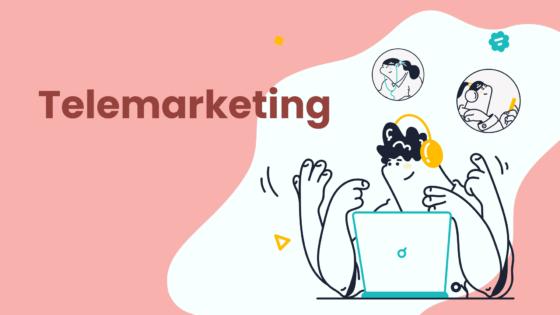
Definition
Customer expectations have reached new heights in the digital age. Today’s customers demand fast, personalized, and seamless experiences across every touchpoint. They expect brands to understand their preferences, anticipate their needs, and deliver consistent service whether they interact via phone, chat, social media, or email. The shift toward mobile-first interactions and the popularity of messaging apps like WhatsApp and WeChat have changed how companies approach customer service. Businesses now face the challenge of handling customer expectations that span multiple channels and require real-time responses.
| Customer Expectation Aspect | Supporting Data | Source |
|---|---|---|
| Personalization | 91% of consumers prefer brands offering personalized offers and recommendations | Accenture study |
| Omnichannel Experience | 73% of customers use multiple channels during shopping | Harvard Business Review |
| Speed and Convenience | 64% of consumers expect real-time interaction and response | Salesforce report |
Impact
High customer expectations shape every aspect of customer service. Companies that fail to meet these expectations risk losing loyalty, seeing higher churn, and damaging their reputation. Customers who receive positive service experiences are 89% more likely to return, while 39% will not come back after poor personalization. Consistency across channels is critical; 75% of customers expect the same level of service everywhere. Meeting customer needs directly impacts retention and revenue. For example, a 5% increase in retention can boost revenue by up to 29%. Businesses that prioritize customer satisfaction and adapt to evolving customer service challenges see stronger loyalty and higher lifetime value.
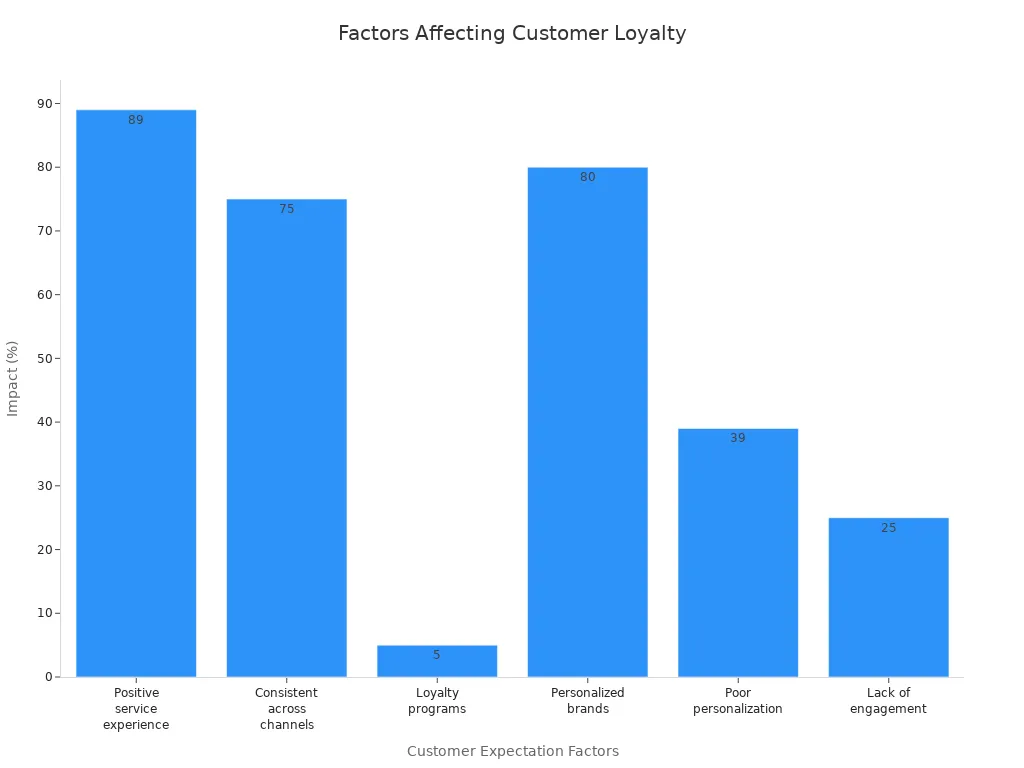
Solutions
Companies can address high customer expectations by adopting proven strategies:
- Collect and act on regular feedback to understand customer needs.
- Personalize every interaction using customer data and AI-driven tools.
- Ensure consistency across all channels with unified platforms like Sobot’s Omnichannel Solution, which integrates chat, voice, and social media for seamless service.
- Train agents to deliver empathetic and effective support.
- Follow up with customers to confirm satisfaction and build trust.
Sobot helps businesses meet these demands by providing an all-in-one contact center that unifies customer service channels, automates routine tasks, and delivers real-time analytics. This approach enables companies to handle customer expectations efficiently and improve customer satisfaction.
Inconsistent Service Quality
Causes
Inconsistent service quality often stems from several common mistakes and gaps within customer service teams. The following table highlights key causes and their impacts:
| Cause | Explanation | Impact on Service Quality | Practical Solutions |
|---|---|---|---|
| Outdated or inefficient systems | Slow, poorly integrated systems cause errors, delays, and data silos. | Frustration, repeated errors, inconsistent answers, slow service | Upgrade to centralized tools, routine system evaluations, data security measures |
| Gaps in employee training | Lack of proper training leads to varied service quality and mistakes. | Inconsistent service, unresolved complaints, disengaged staff | Comprehensive onboarding, ongoing learning, feedback-driven improvements |
| Mismanagement of policies | Vague or conflicting policies cause confusion and inconsistent decisions. | Customer frustration, escalated complaints, damaged trust | Clear, concise policies, employee training on policies, proactive customer notifications |
| Inconsistent information | Mixed messages cause customer confusion and distrust. | Confusion, distrust | Centralized self-service resources, monitoring tools, team alignment, consistent training |
Many customer service challenges arise when companies prioritize cost over quality, lack clear objectives, or select vendors without proper vetting. These issues can lead to service failures and dissatisfied customers.
Effects
Inconsistent service quality has measurable effects on both customer satisfaction and business performance:
- Customers experience confusion, frustration, and missed opportunities, which reduce satisfaction and loyalty.
- Trust in the brand declines, leading to increased customer churn and more complaints.
- Businesses see higher numbers of unresolved tickets, longer first response times, and increased average ticket handling times.
- These metrics often result in lower customer satisfaction scores (CSAT) and net promoter scores (NPS).
- Employee engagement and efficiency also drop, affecting overall business outcomes.
Consistent quality standards in customer service increase retention, loyalty, and profitability. Companies that align service standards with business objectives see improved brand reputation and employee morale.
Best Practices
To address these customer service challenges, organizations can adopt proven best practices:
- Develop a customer service charter that defines quality standards and expectations.
- Conduct regular customer satisfaction surveys to gather feedback and identify areas for improvement.
- Streamline processes by removing unnecessary steps and offering clear self-service options.
- Implement automation tools like Sobot’s AI-powered chatbots and unified workspaces to reduce errors and boost efficiency.
- Establish a feedback loop to continuously identify bottlenecks and enhance the customer experience.
- Commit to ongoing training and track key performance indicators such as response times, resolution rates, and satisfaction scores.
Sobot’s all-in-one contact center solution helps businesses maintain consistent service quality by centralizing communication channels, automating routine tasks, and providing real-time analytics for continuous improvement.
Slow Response Times
Reasons
Slow response times remain one of the most common customer service challenges. Several factors contribute to delays in customer service environments:
- Long waiting times in queues often result from insufficient staffing or poor queue management.
- Ineffective communication can confuse customers, especially when updates are not timely.
- Limited feedback channels prevent businesses from identifying issues quickly.
- Overwhelming ticket volumes create bottlenecks, delaying responses.
- Knowledge gaps arise when experienced staff handle only severe cases, leaving less experienced agents to manage general inquiries.
- Rapid changes in technology require constant learning, which can slow down support teams.
These issues highlight why many organizations struggle to deliver prompt customer service.
Customer Impact
Slow response times have a direct effect on customer satisfaction and business reputation. Customers often feel frustrated or neglected when they wait too long for help. This perception can lead to a loss of trust in the company’s ability to meet expectations. Delays may push customers to seek faster service from competitors. Negative experiences also increase the likelihood of poor word-of-mouth, which can damage a brand’s reputation. Missed opportunities for upselling or cross-selling further impact business growth. Companies that fail to address these customer service challenges risk losing both loyalty and revenue.
Quick responses show customers they matter. Delays send the opposite message.
Improving Speed
Businesses can overcome slow response times by adopting proven strategies and technologies:
- Intelligent call routing systems, such as Automatic Call Distribution (ACD), connect customers with the right agents quickly.
- Workforce management tools forecast demand and optimize staffing schedules.
- Real-time analytics dashboards allow managers to monitor performance and intervene when needed.
- AI-powered chatbots and virtual agents handle routine inquiries instantly, freeing human agents for complex issues.
- Comprehensive training programs improve agent knowledge and communication skills.
Sobot’s all-in-one contact center solution integrates these features, offering intelligent routing, AI-powered chatbots, and real-time analytics. Companies using Sobot can reduce average response times and improve customer service efficiency. By streamlining workflows and automating routine tasks, Sobot helps businesses address customer service challenges and deliver faster, more reliable support.
Omnichannel Support Challenges

Integration
Businesses often struggle to integrate multiple communication channels into a single, unified system. Many organizations face data silos, where customer information gets trapped in separate platforms. This fragmentation makes it hard to deliver a seamless customer support experience. According to recent surveys, about 31% of marketing executives identify data application and integration as their top challenge. Legacy systems can slow down integration, leading to manual errors and slow order processing. Staff must also adapt to new tools, which requires ongoing training. Security risks increase as more third-party vendors become involved in customer interaction. These integration challenges can reduce efficiency and make it difficult to provide high-quality customer service.
Companies that overcome integration barriers can engage customers on their preferred channels, improving satisfaction and loyalty.
Consistency
Maintaining consistent service quality across all channels is another major challenge. Each platform—whether chat, email, voice, or social media—has unique demands. Data silos and fragmented processes often cause inconsistent customer interactions. Customers may need to repeat information when switching channels, which leads to frustration. Coordination issues within teams can slow down responses and reduce the overall quality of customer support. Organizations must also ensure that branding and messaging remain uniform, which builds trust and strengthens brand identity. Continuous staff training and clear processes are essential for delivering consistent customer service and improving efficiency.
| Challenge | Impact on Customer Support | Solution Needed |
|---|---|---|
| Data silos | Inconsistent customer interaction | Unified data management |
| Lack of coordination | Slow, inadequate responses | Better internal communication |
| Channel-specific demands | Service quality varies | Standardized processes |
Sobot Omnichannel Solution
Sobot addresses these challenges with its advanced omnichannel solution. The platform integrates chat, email, voice, and social media into a single AI-powered workspace. This unified approach eliminates data silos and ensures every customer interaction is tracked and managed efficiently. Sobot’s AI tools, such as AI Copilot and intelligent voicebots, help agents resolve issues faster and provide personalized support. The system offers real-time analytics, allowing managers to monitor performance and optimize operations. Sobot’s solution supports 24/7 customer support, handling high inquiry volumes without sacrificing service quality. The platform also ensures data privacy and compliance, with regional data centers for reliable global performance. Businesses using Sobot report higher customer satisfaction, improved agent productivity, and greater efficiency in their customer service operations.
Sobot empowers organizations to deliver seamless, consistent, and efficient customer support across every channel.
Lack of Personalization
Importance
Personalization stands as a cornerstone of modern customer experience. Customers expect brands to recognize their preferences and respond to their unique customer needs. When companies fail to personalize, customers often feel like just another number. This lack of attention can erode trust and reduce customer loyalty. Research shows that 82% of consumers say personalization influences their brand choices in at least half of their shopping decisions (source). Personalization in customer service tailors each interaction, making customers feel valued and understood. Companies that invest in personalization see higher engagement rates and improved customer lifetime value.
Customers who feel personally valued are more likely to return and recommend the brand to others.
Customer Experience
A personalized customer experience transforms every touchpoint. Customers want consistent, relevant communication whether they use email, chat, phone, or social media. Data-driven personalization uses CRM integration and AI analytics to deliver tailored experiences in real time. Proactive support anticipates customer needs, solving problems before they arise. This approach builds trust and strengthens customer loyalty. Hyper-personalized service addresses specific pain points, preventing churn and fostering long-term relationships. Key metrics such as satisfaction scores, retention rates, and customer lifetime value reflect the positive impact of personalization on customer experience.
- Personalization tailors interactions based on individual behaviors and preferences.
- Consistent messaging across all channels builds trust and loyalty.
- Proactive, predictive support improves relationships and retention.
Personalization Tools
Modern technology makes personalization possible at scale. Companies use AI-driven segmentation to identify micro-segments and deliver targeted messages. Personalization engines analyze customer data in real time, recommending relevant products and content. AI-powered chatbots provide 24/7 support, adapting responses to customer needs. Customer Data Platforms (CDPs) aggregate information from multiple sources, creating rich profiles for each customer. Sobot’s all-in-one contact center solution integrates these tools, enabling businesses to deliver seamless, personalized customer experiences across every channel. Cloud computing and mobile apps ensure that support remains responsive and contextually relevant, no matter where the customer interacts.
Investing in the right personalization tools leads to higher satisfaction, stronger customer loyalty, and long-term business growth.
Technology Integration Issues
Common Problems
Technology integration remains a major challenge for customer support teams. Many organizations struggle to connect multiple platforms, leading to data silos and inconsistent customer interaction. The table below highlights the most common issues:
| Common Technology Integration Issues | Description |
|---|---|
| Multichannel Communication | Managing inquiries across platforms like chat, email, and phone requires unified systems. |
| Automation Integration | Balancing automation with personal service can be difficult. |
| Adapting to New Technologies | Teams must keep up with AI, chatbots, and voice assistants. |
| Training and Skill Development | Agents need ongoing training to use new tools. |
| Data Privacy and Compliance | Security and regulations like GDPR must be followed. |
| Operational Efficiency | Streamlining workflows without losing quality is essential. |
| Remote Work Challenges | Supporting remote agents with reliable tools is necessary. |
Customer service teams also face long lists of integration requests, especially when connecting with HR or CRM systems. These requests can slow down operations and reduce efficiency.
Sobot Voice/Call Center
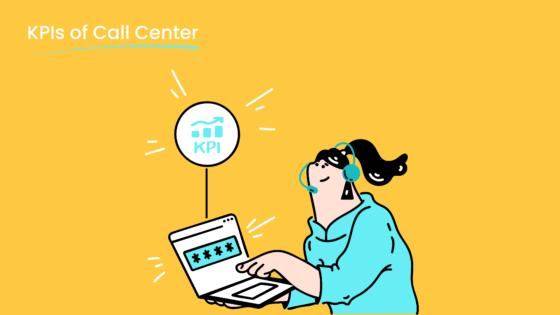
Sobot Voice/Call Center offers seamless integration and advanced AI capabilities. The platform supports 24/7 automated customer support, ensuring immediate help at any time. Multilingual support allows businesses to engage customers globally. Sobot’s intelligent knowledge base integration delivers accurate, AI-driven responses. No-code implementation means companies can adopt the system quickly, even without technical expertise. Advanced analytics and reporting provide deep insights into every customer interaction, helping managers track performance and improve efficiency. Sobot’s AI features, such as transcription and sentiment detection, have led to a 45% decrease in escalation rates and a 30% increase in upsell performance.
Sobot enables businesses to deliver consistent, efficient customer support across all channels, improving both agent productivity and customer satisfaction.
Integration Tips
Successful integration of CRM and omnichannel platforms requires careful planning. Companies should set clear goals, involve key stakeholders, and create a detailed timeline. Connecting CRM and contact center tools, customizing workflows, and migrating data accurately are crucial steps. Testing and optimizing the system ensures reliability. Training agents with hands-on sessions and ongoing support helps them manage customer support tasks effectively. Businesses should choose scalable solutions with robust APIs and unified customer profiles. Automation tools can reduce manual work and boost efficiency, while continuous feedback and performance analysis drive ongoing improvement.
Insufficient Training
Training Gaps
Many customer service teams face significant training gaps that hinder performance. Companies often discover these gaps by using surveys, practical assessments, and 360-degree reviews. The most common issues include weak communication skills, poor conflict resolution, and limited product knowledge. Employees sometimes struggle with essential tools like POS terminals or CRM systems. Skill matrices and training needs assessments help visualize where teams fall short. Monitoring and on-the-job observations also reveal gaps in real time. These gaps can lead to inconsistent service and missed business goals.
Regularly assessing employee skills ensures that training and skill development efforts target the most urgent needs.
Service Impact
Insufficient training directly affects customer service outcomes. Agents who lack proper training often deliver inconsistent performance. Customers may notice fluctuating service quality, which can reduce satisfaction and trust. Repeated complaints signal that agents do not have the skills or knowledge to resolve issues quickly. Teams that struggle with operational procedures or new technology create unpredictable experiences for customers. Monitoring performance metrics and customer feedback helps identify these problems early. Addressing training gaps improves both agent proficiency and the overall customer experience.
- Agents with hands-on experience answer questions more effectively.
- Self-directed learning supports continuous improvement.
- Quick access to support between training sessions prevents poor experiences.
Training Solutions
Effective training solutions address both technical and soft skills. Companies see the best results when they tailor programs to their business needs. Interactive workshops and scenario-based training prepare agents for real-life challenges. Ongoing access to resources like eBooks and case studies reinforces learning. Training should cover empathy, active listening, and crisis management, as well as technical skills like using CRM tools. Feedback from customers helps personalize future training. Sobot offers unified platforms that support continuous learning and skill development, helping teams stay updated and confident in their roles.
Investing in comprehensive training programs leads to higher customer satisfaction and stronger team performance.
Handling Difficult Customers
Types
Customer-facing teams encounter many types of difficult customers. Each type brings unique challenges to the customer experience. Common examples include:
- Impatient Customer: Upset about wait times and quick to express frustration.
- Indecisive or Quiet Customer: Unsure about choices and slow to respond.
- Vague Customer: Struggles to explain needs, making it hard to provide solutions.
- Unhappy Customer: Dissatisfied with service and may request compensation.
- Demanding Customer: Insists on specific solutions, often ignoring alternatives.
- Frequent Complaints: Regularly contacts support with issues or negative feedback.
- Unrealistic Expectations: Requests features or outcomes beyond what is possible.
| Type of Difficult Customer | How to Identify | How to Help |
|---|---|---|
| Frequent Complaints | Repeated negative feedback or social media posts | Listen calmly, empathize, and act on valid feedback |
| Hard to Satisfy | Focuses on unmet expectations | Ask for specific needs and offer fair alternatives |
| At Risk of Churning | Mentions competitors or past bad experiences | Proactively communicate and offer incentives |
| Indecisive | Vague about needs, asks for suggestions | Ask clarifying questions to guide decisions |
| Unrealistic Expectations | Refuses to accept limitations | Set clear boundaries and explain capabilities |
Effects
Difficult customers can impact the customer experience in several ways. They may increase stress for agents, slow down response times, and lower team morale. Negative interactions can lead to poor reviews and damage a brand’s reputation. According to a PwC study, 32% of customers will stop doing business with a brand after just one bad experience. High volumes of complaints or escalations can overwhelm support teams, making it harder to meet customer expectations. Companies that fail to address these challenges risk losing loyal customers and seeing a decline in satisfaction scores.
A single negative customer experience can have a ripple effect, influencing other potential customers through word-of-mouth and online reviews.
De-escalation
Effective de-escalation techniques help turn challenging situations into positive outcomes. Teams can use these strategies to improve the customer experience:
- Remain calm and composed, even if the customer is upset.
- Practice active listening and show empathy to validate feelings.
- Communicate clearly, letting the customer speak before responding.
- Focus on problem-solving by asking open-ended questions and offering solutions.
- Use positive language to highlight what can be done.
- Set respectful boundaries if the customer becomes abusive.
- Practice mindfulness, such as deep breathing, to stay professional.
- Pay attention to tone and body language to convey care and attentiveness.
Sobot’s unified workspace and AI-powered tools support agents in managing difficult interactions by providing real-time information and suggested responses. This technology helps teams resolve issues faster and maintain a high standard of customer service, even in stressful situations.
High Agent Turnover
Causes
High agent turnover remains a persistent challenge in customer service. Several factors contribute to this issue:
- Stressful work environments often lead to burnout, especially when agents handle frustrated customers daily.
- Repetitive and monotonous tasks can cause boredom and disengagement.
- Low pay compared to similar professions makes it hard to retain skilled agents.
- Limited career advancement opportunities create a sense of stagnation.
- Demanding performance targets increase pressure and stress.
- Poor company culture, including weak management relationships and lack of recognition, lowers morale.
- Inadequate training leaves agents feeling unprepared and less confident.
A recent survey found that 52% of customer experience leaders cite burnout as a top reason for attrition. The rise of AI in contact centers automates about 41% of interactions, which can also lead to confusion or resistance among long-time agents. As experienced agents leave, companies struggle to find and retain new talent, especially when competitors offer higher pay.
Impact
High agent turnover affects both operational costs and service quality. Organizations face increased expenses for recruiting, onboarding, and training new staff. The average cost per hire is about $4,700, with onboarding adding up to $1,830 per employee (source). Service quality declines as new agents take time to reach proficiency, leading to longer handling times and more errors. Loss of institutional knowledge slows issue resolution and disrupts customer relationships. Remaining agents face heavier workloads, which can cause further burnout and lower morale. Customer satisfaction drops when inexperienced agents struggle to resolve issues quickly, damaging brand reputation and loyalty.
High turnover disrupts workforce planning, increases compliance risks, and harms organizational culture.
Retention
Companies can reduce agent turnover by adopting proven retention strategies:
- Analyze compensation, exit interviews, and tenure data to identify root causes.
- Monitor agent satisfaction and engagement to address risks early.
- Offer ongoing skills training, career progression, and rewards programs.
- Equip agents with advanced tools like Sobot’s AI-powered workspace, which automates repetitive tasks and supports efficient workflows.
- Foster a positive culture that values feedback, work-life balance, and recognition.
- Use real-time agent guidance and coaching to accelerate training and boost confidence.
- Implement continuous improvement practices, encouraging feedback and operational enhancements.
A case study showed that one company improved agent retention by 50% within three months by using AI-powered coaching and reinvesting in agent bonuses. Sobot’s unified platform helps businesses support agents with modern technology, making their roles more engaging and reducing turnover.
Data Privacy and Security
Risks
Data privacy and security risks in customer care can cause serious harm to both businesses and customers. Companies face many threats, including:
- Personal data loss, which can lead to identity theft or phishing scams.
- Legal problems from not following data protection laws.
- Financial loss due to fraudulent accounts or illegal transactions.
- Business interruptions caused by cyberattacks.
- Reputational damage when customers lose trust after a breach.
- Human errors from insufficient employee training.
- Weaknesses from third-party vendors who lack proper security.
- Data silos that create gaps and inefficiencies.
- No incident response plan, making breaches harder to manage.
- Poor access controls and lack of continuous monitoring.
Other common threats include phishing attacks, malware, unsecured networks, insider threats, and outdated security systems. Even a single mistake can expose sensitive information and disrupt customer service.
Companies must stay alert and invest in strong security measures to protect customer data and business operations.
Compliance
Following data privacy laws is essential for every organization. Regulations like GDPR, CCPA, and LGPD set strict rules for handling personal information. Certified privacy managers help companies meet these standards by overseeing data processing and conducting risk assessments. Failure to comply can result in heavy fines and loss of customer trust. Ethical risks, such as AI bias and social engineering, also require attention. Companies need strong information security management systems to address these challenges and keep customer service safe and reliable.
Sobot Security
Sobot takes data privacy and security seriously. The platform uses secure, encrypted data transfer to protect every customer interaction. Sobot’s system maintains a 99.99% uptime, ensuring that customer service remains available and reliable at all times. The company operates global data centers and follows strict access controls to prevent unauthorized access. Real-time monitoring and regular updates help Sobot stay ahead of new threats. By choosing Sobot, businesses gain peace of mind knowing their customer data is safe and their operations are protected.
Managing Customer Feedback
Collection
Companies collect customer feedback through many channels. They use surveys, online reviews, social media, and direct conversations. According to a Microsoft report, 77% of customers view brands more favorably if they invite and accept feedback. Businesses often use digital tools to gather opinions after each interaction. Sobot’s omnichannel platform helps companies collect feedback from chat, email, and phone in one place. This unified approach makes it easier to track trends and understand the full customer experience.
Analysis
Analyzing feedback helps companies spot patterns and improve the customer experience. Teams review comments, ratings, and survey results to find common issues or praise. They use data analytics to measure satisfaction scores and track changes over time. For example, a sudden drop in ratings may signal a problem with a new product or service. Sobot’s analytics dashboard gives managers real-time insights into customer sentiment. This tool highlights areas where customer service can improve and where teams already excel. By using these insights, companies can make better decisions and create a more positive customer experience.
Tip: Regular analysis of feedback helps companies stay ahead of problems and build stronger relationships with customers.
Action Steps
Taking action on feedback is key to improving the customer experience. Companies should respond quickly to complaints and thank customers for positive comments. They can use feedback to train staff, update policies, or change products. Sobot’s ticketing system lets teams assign and track follow-up tasks, ensuring no feedback gets ignored. Businesses that act on feedback see higher loyalty and better results. For example, companies that resolve issues quickly can increase customer retention by up to 70% (source). By closing the loop, companies show they value every customer and strive for excellent customer service.
Scaling Customer Service Operations
Growth Challenges
Companies often face new hurdles as they expand customer support operations. Increased customer inquiries can overwhelm teams. Maintaining service quality becomes harder with more channels and higher volumes. Many organizations struggle to keep up with rapid growth, especially when using outdated systems. Hiring and training new agents takes time and resources. Without the right tools, teams may see longer response times and lower satisfaction scores. Businesses must also ensure data security and compliance as operations scale. These challenges can impact customer loyalty and brand reputation.
| Strategy / Benefit Category | Description |
|---|---|
| Invest in scalable customer service tools | Use platforms that grow with your team and simplify operations, such as AI-powered automation. |
| Leverage AI assist tools | Streamline workflows, reduce handling time, and suggest real-time responses. |
| Empower customers with knowledge base | Provide self-service tools to reduce support tickets. |
| Continuous process optimization | Review KPIs and fine-tune workflows to maintain quality while scaling. |
Sobot Solutions
Sobot offers a robust solution for scaling customer support. The platform supports high-volume interactions across chat, voice, email, and social media. Sobot’s AI-powered automation handles routine inquiries, freeing agents to focus on complex issues. The unified workspace gives agents a complete view of each customer, improving efficiency. Sobot’s cloud-based system ensures 99.99% uptime, so businesses stay connected with customers worldwide. Agilent, a global leader in life sciences, used Sobot to manage a surge in customer support requests. By integrating Sobot’s omnichannel workbench and AI chatbot, Agilent increased service efficiency sixfold and reduced costs by 25%. Their customer satisfaction score reached 95%, showing the impact of scalable solutions.
Best Practices
Organizations can scale customer support effectively by following these best practices:
- Deploy chatbots for 24/7 support and route complex issues to agents.
- Use AI tools to assist agents with real-time suggestions and automate communication.
- Build a comprehensive knowledge base for customer self-service.
- Provide continuous training and coaching for agents.
- Embrace an omnichannel approach to meet customers on their preferred channels.
Tip: Regularly review performance metrics and gather feedback to optimize processes as customer support operations grow.
The 12 challenges of customer care shape every part of customer support. These customer service challenges can lower customer satisfaction and hurt customer loyalty. Companies that address customer support challenges see better customer experience and stronger results. Sobot helps businesses solve customer support challenges with AI-powered tools and unified platforms. Continuous improvement drives higher customer loyalty and better customer experience. Teams should review their customer support strategies often. Proactive steps and continuous improvement help companies reach new levels of customer satisfaction. For more on Sobot’s solutions, visit Sobot’s official website.
FAQ
What are the most common customer service challenges businesses face?
Many businesses struggle with high customer expectations, slow response times, and inconsistent service quality. According to a Salesforce report, 80% of customers say the experience a company provides is as important as its products (source). Addressing these customer service challenges improves customer satisfaction.
How does Sobot help improve customer care and customer experience?
Sobot provides an all-in-one contact center solution. It unifies chat, voice, and social media channels. Sobot’s AI-powered tools automate routine tasks and offer real-time analytics. These features help businesses overcome customer support challenges and deliver a seamless customer experience.
Why is personalization important in customer support challenges?
Personalization increases customer satisfaction and loyalty. Research shows that 82% of consumers prefer brands that personalize interactions (source). Sobot’s platform uses AI to tailor responses, making every customer care interaction unique and effective.
What role does data security play in customer care?
Data security protects customer information and builds trust. A single breach can damage customer experience and loyalty. Sobot ensures secure, encrypted data transfer and maintains 99.99% uptime. This commitment helps businesses meet strict privacy standards and maintain high customer satisfaction.
How can companies scale customer support operations effectively?
Companies can scale customer care by using AI-powered automation, unified workspaces, and omnichannel solutions. Sobot’s platform supports high-volume interactions and provides 24/7 support. For example, Agilent increased customer service efficiency sixfold with Sobot, improving both customer satisfaction and operational performance.
See Also
How To Successfully Deploy Omnichannel Contact Center Systems
Leading Customer Support Software Options To Consider In 2024
Effective Strategies For Managing Quality In Call Centers
Key Recommendations To Improve Live Chat Customer Experience
Essential Guidelines For Selecting Social Media Support Tools
